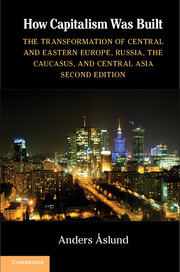 How Capitalism Was Built
How Capitalism Was Built Book contents
- Frontmatter
- Contents
- List of Tables and Figures
- Acknowledgments
- List of Abbreviations
- Introduction
- 1 Communism and Its Demise
- 2 Radical Reform versus Gradualism
- 3 Output
- 4 Liberalization
- 5 From Hyperinflation to Financial Stability
- 6 Privatization
- 7 The Social System
- 8 The Politics of Transition
- 9 From Crime Toward Law
- 10 The Importance of the European Union
- 11 The Global Financial Crisis, 2007–2012
- 12 Conclusions
- Bibliography
- Index
3 - Output
From Slump to Recovery and Boom
Published online by Cambridge University Press: 05 December 2012
- Frontmatter
- Contents
- List of Tables and Figures
- Acknowledgments
- List of Abbreviations
- Introduction
- 1 Communism and Its Demise
- 2 Radical Reform versus Gradualism
- 3 Output
- 4 Liberalization
- 5 From Hyperinflation to Financial Stability
- 6 Privatization
- 7 The Social System
- 8 The Politics of Transition
- 9 From Crime Toward Law
- 10 The Importance of the European Union
- 11 The Global Financial Crisis, 2007–2012
- 12 Conclusions
- Bibliography
- Index
Summary
A fundamental but poorly understood issue of postcommunist economic transformation is what happened to output. There is no agreement on the fundamental facts, and the statistical uncertainties are too great for any consensus to emerge any time soon. Throughout the region, transition started with huge recorded falls in output. Some argued that a unique devastation was taking place; others saw a combination of measurement problems and “creative destruction” in Joseph Schumpeter’s (1943/1976) sense.
The universal output slump after communism has been greatly exaggerated. Output did fall, but not nearly as much as officially recorded. A substantial part of the big recorded decline, probably about half, was not real but can be explained with factors such as mismeasurement, an expansion of the unregistered economy, and the elimination of value detraction. In addition, several countries lost substantial subsidies and many implicit trade subsidies. The main economic concern was the long delay in economic recovery in many countries rather than the initial slump.
The initial development of output was closely correlated with reform policies. The output fall lasted much longer and was steeper in the former Soviet Union than in Central and Eastern Europe. The two extremes were the neighbors Poland, which returned to growth in its third year of transition, and Ukraine, which experienced ten years of economic decline. Radical reformers soon returned to growth, whereas partial and nonreformers experienced a long period of contraction. The covariation between many possible causes makes it impossible to distinguish the decisive reason, but hyperinflation and the general collapse of the state are strong candidates.
- Type
- Chapter
- Information
- How Capitalism Was BuiltThe Transformation of Central and Eastern Europe, Russia, the Caucasus, and Central Asia, pp. 65 - 91Publisher: Cambridge University PressPrint publication year: 2012


